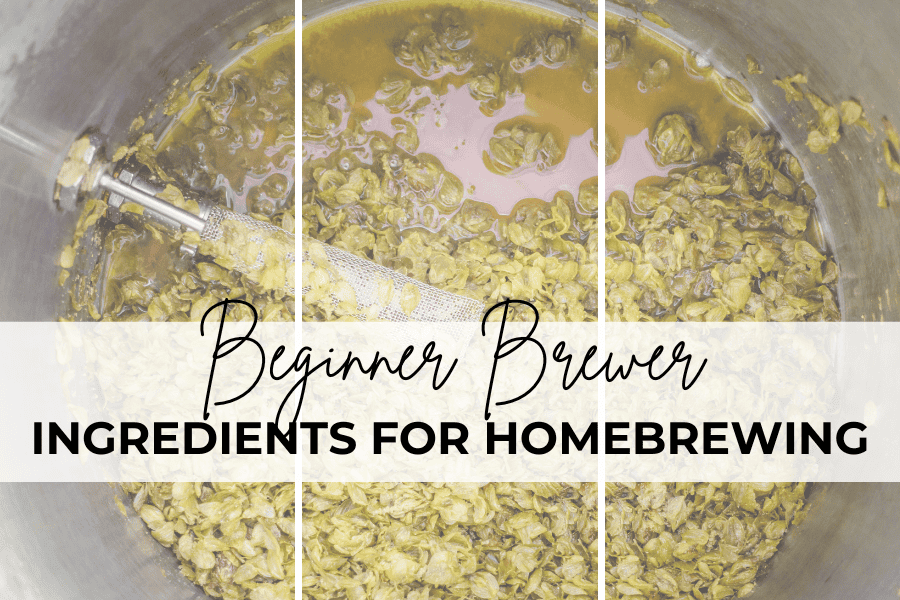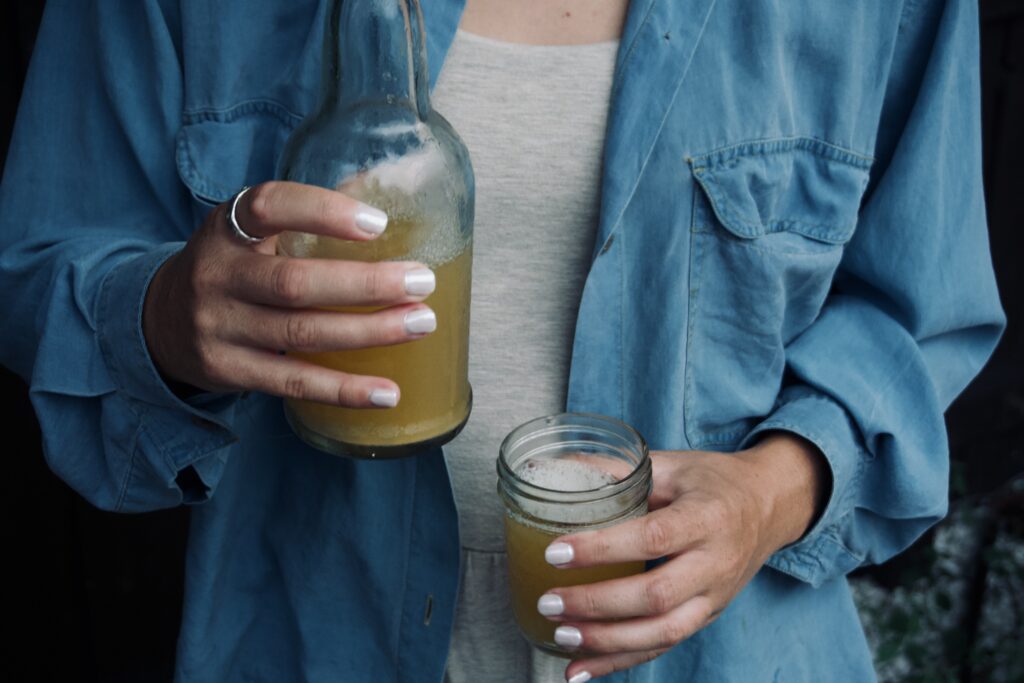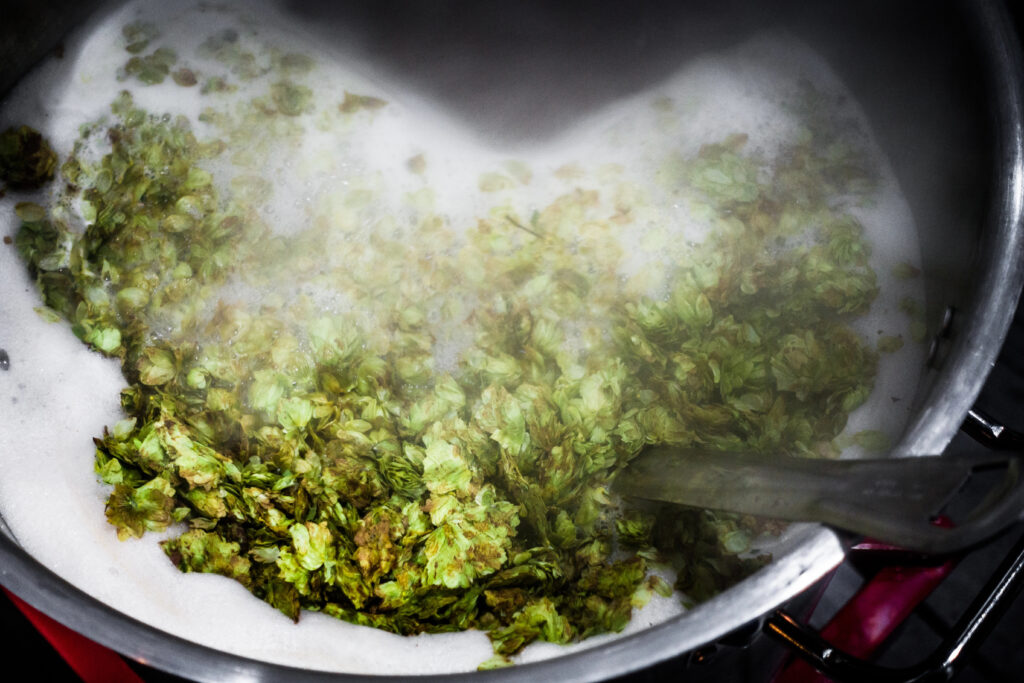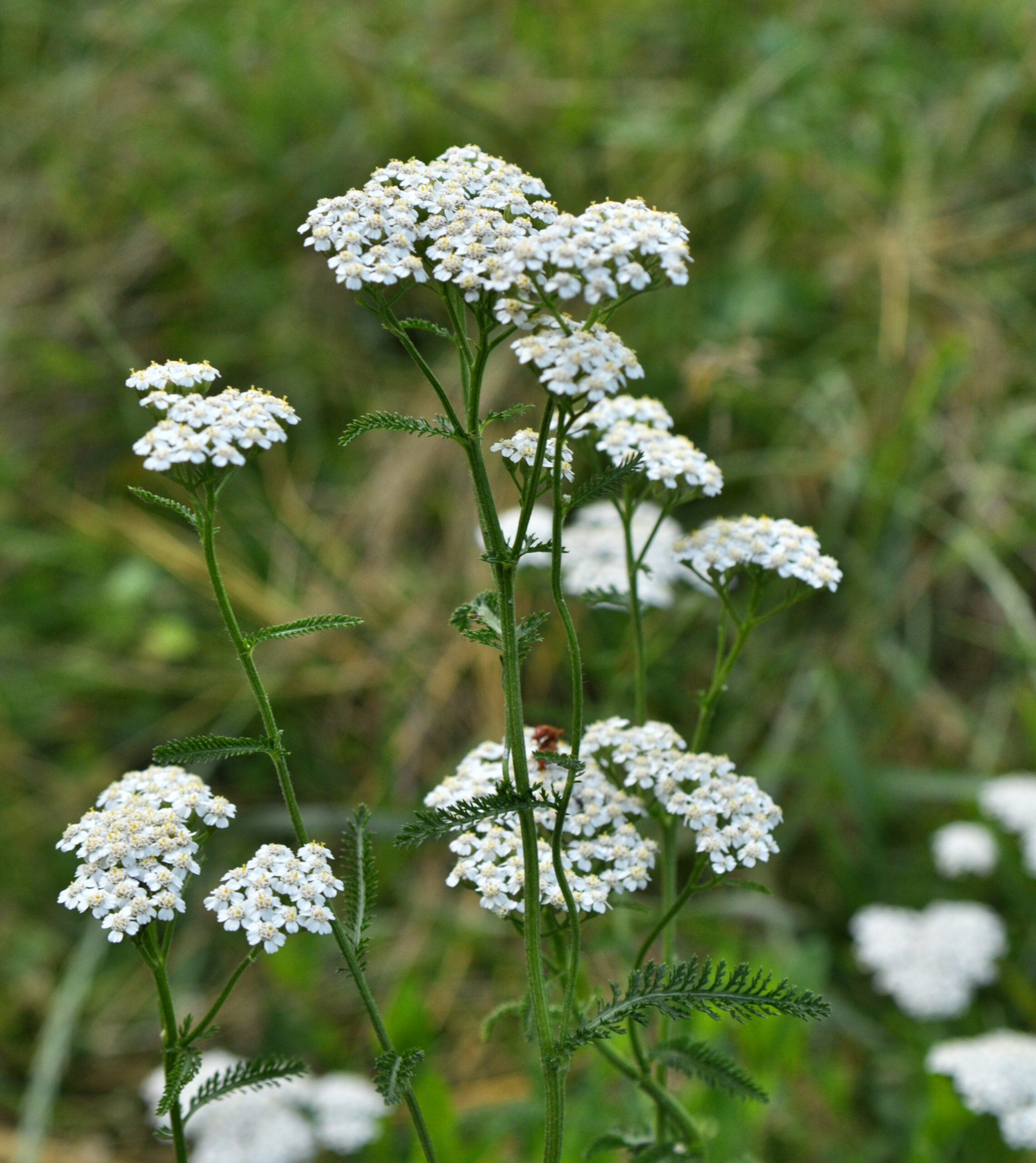You probably know by now that ingredients for homebrew (and all brews) are yeast, malt, water, and hops. These 11 other vital ingredients for homebrewing will make brewing way easier and craft amazing beers.

Beginning to brew your own beer is a sacred and beautiful process AND you get to share it with your friends and family. What gets better than that??
When I started homebrewing I was overwhelmed by the science, the equipment, the process, all of it! Until I was able to break down the ingredients for homebrew and find my flow.
Here you will learn about the 4 main ingredients in beer and then the 11 best beer brewing ingredients beginners must know about!
After learning about the ingredients for homebrew, you will become a beer pro and be prepared to start brewing with confidence and ease.
This post is all about ingredients for homebrew and the best beer brewing ingredients for beginner brewers.
Ingredients for Homebrew

The 4 Main Ingredients in Beer
The 4 main ingredients in beer are malt, hops, yeast, and water. We will dive into each specifically to understand their role in crafting dank beers.
1. Malt
Malt. The Soul of Beer, as most brewers know it to be. Malt is the roasting, or toasting, of specialty grains. For example, roasted barley, black barley, chocolate malt, etc.
The malt is soaked in hot water on the stove, propane burner, or commercial kettle. This extracts the fermentable sugars within the malt releasing them into the hot water. The yeast LOVE eating up all the malted sugars during fermentation.
2. Hops
Hops are the flower of the plant Humulus lupulus, which is a cousin to the Cannabis plant. These flowers are added into “the boil” of beer making to add bitterness, aroma, and flavor. We add hops for bitterness to offset the sweetness of the malted grain.

The Duke of Bavaria in 1516 created the Purity Law that beer can only be barley, water, and hops. Which was mostly in place to protect the wheat and rye supply for breadmakers and bakers, not so much beer.
Though, the Purity Law ceases to exist it still formed our brewing culture today. Before the extensive use of hops for flavor and aroma brewers were using herbs and spices.
Mugwort beer, yarrow beer, and even lavender beers are becoming more popular as homebrewers step back into herbal beers.
In my experience, brewing with herbs is an unparalleled experience. Especially when I get fresh herbs and pair them with their medicinal properties. For example, lemon balm beer for sedation and relaxation or lemon zest beer for better digestion.
Hops are the driving force of flavor and aroma in beers you find in stores and local breweries. There is extensive potential of pairing hops together to achieve magnificent beers.
3. Yeast
The metabolic pathway to alcohol! Yeast are added after the malt and hops once the liquid has cooled. Yeast is added to start the fermentation process. As a result, the yeast eat the fermentable sugars from the malt and bam, you get alcohol.
4. Water
Water is a vital ingredient for homebrew. Where you source your water is really important for the quality of the beer you are producing. Whether you are using RO water, tap water, or bottled spring water… the source MATTERS!
For example, if there is too much chlorine, calcium, sodium, etc. in your water source your beer is subject to funky flavors.
If your water is tasty to drink then it will probably make great beer. If you are like me and your tap water is garbage, then you can go to your local grocery store and get a gallon or so of the top quality spring water.
Brewing water chemistry can be an interesting rabbit hole to dive into. Though, I have found I don’t need to mess with my water if I get it from a reliable source. Here is a good reference to brewing water chemistry for beginners.
RELATED POST: 4 Top-Notch Beer Recipe Kits You Need for Insanely Good Beer
11 Best Beer Brewing Ingredients for Beginner Brewers

BEST beer brewing ingredients for beginners! These are amazing products I wish I knew more about when I started brewing at home. It would have saved me time and money! I know you are going to love them.
1. Dry malt extract
Dry malt extracts are fermentable sugars in a powder form. They replace the need for grains when you are making beer. This product makes homebrewing way easier and more approachable for beginners.
You can get a one pound bag and brew a great 1 gallon beer recipe at a reasonably good price. Personally, this is my favorite “all-grain” alternative when brewing at home.
2. Liquid malt extract
Liquid malt extracts are essentially the same thing as dry malt extract except… it’s liquid. Shocking. So, liquid malts are also a great alternative to all-grain brewing. The product is a 3.3 pound jug and you only need one pound for 1 gallon beer recipe.
Therefore, liquid malt extracts are going to be cheaper than the dry malt extract. Though, I will warn you that the liquid malt can get very messy sticky very fast. That’s why I enjoy using dry malt, I just pour the powder in and done! No measuring, no sticky mess, no worries.
3. Cascade hops
Oh cascade! Such a lovely, all loving hop. I tend to use cascade alongside my herbal additions to beer and it is chefs kiss. Cascade hops are great when brewing American Pale Ale or IPA style homebrews.
They are known for their grapefruit, floral, and pine flavors and aroma. C’mon, that sounds so amazing!! A bit citrusy, a bit floral, and a bit earthy this hop literally has it all. Pair with fresh lemons, dried lavender, or even pine needles to compliment those hops flavors.
4. Centennial hops
Centennial hops are also great for American Pale Ale and IPA style beer.
They are going to be similar to Cascade but without the piney/earthy flavors. So, they are mostly known for delivering lemony and floral flavors. Again, pair with fresh oranges or dried herbs to accentuate those citrusy floral yummyness!
RELATED POST: A Complete Guide to Beer Making for Beginners
5. Dried hops
Hop pellets are the most prominent type of hops in the brewing world. It is when the producers dry the hop flowers, crush them up into powder, and then press them into small pellets for preservation and distribution.
Using dried hops is another way to connect with your beer and your ingredients. You can use these dried hops for beer, tinctures, teas, etc. (hops have great medicinal properties!)
Yakima Valley Hops are a highly revered hop company out of Washington. They have hop farms, so it’s like farm-to-table for beer. I haven’t personally used Yakima Valley Hops, though they are on my list.
6. Yarrow & Mugwort Herbs

Welcome to herbal beers! Yarrow and mugwort are fantastic bittering herbs and great ingredients for homebrew.
Just like hops are bittering, yarrow and mugwort help counter balance the sweetness in the malt. I would recommend to start with yarrow, as mugwort is extremely bitter.
I love working with yarrow. They hold some great medicinal properties in addition to adding bitterness and mellow flavor to beers. Keep in mind: The bitterness levels can vary depending on where you source from.
RELATED POST: How I Made a Homemade Beer Recipe with Lion’s Mane for Increased Cognitive Function
If you are interested in tapping into the herbal beer side of homebrewing, these two herbs are a great place to start. You can easily pair them with lemon, coriander, cinnamon, pumpkin, etc.
You can find yarrow or mugwort at your closest apothecary or herbal shop. I linked Rebecca’s Apothecary in Boulder, CO. Personally, I love every single one of their products!
7. Wyeast yeast
Wyeast is hands down my favorite commercial beer yeast.
It must stay chilled and is liquid form, which makes me think it is high quality (and it is!). It creates beautiful flavor and fermentation doesn’t go too fast or too slow. Therefore, you know the flavors are being elegantly integrated.
The package is for a 5 gallon batch of beer. If you are using it for 1 gallon beer recipes, I suggest to only use 1/5th and then store the rest in the fridge. But, make sure to use it up quickly!
If you are looking for top quality yeast, Wyeast will be your best friend.
8. Safale us-05 yeast
Safale is the most standard dried brewing ale yeast. You can use a little here, a little there, wrap it up, and store it away for later.
It is very versatile when brewing. I even use it to inoculate my homemade sodas as well.
9. Wild yeast starter
When you want to play around with cultivating your own yeast, a wild yeast starter is a really fun, affordable, and convenient way to inoculate your homebrew.
You can make a wild yeast starter from ginger, water, and organic cane sugar. Ginger has naturally living yeast on it’s skin so feeding the yeast with some sugar and water will allow that yeast population to grow.
Then, when you are ready to pitch your yeast into your beer you can take about 1/2 cup of the yeast starter liquid and pour it into the fermenter!
RELATED POST: How to Make a Yeast Starter in 8 Easy Steps for Unreal Fermented Drinks
10. PRIMO water
It is hard to argue that water does NOT play a huge role in the beer’s quality. It is the veins of the beer, as beer is 90-95% water.
If your tap water is not good to drink, or taste weird on its own, it will probably taste weird in beer as well. Water jugs from the supermarket are an option, but I find they leave a plasticky taste.
I recommend finding a PRIMO water supplier. They have a “Store Finder” so you can find the closest refill station near you. They purify the water, run it through RO, and then add nutrients back in for taste and hydration benefits. It is a great option for brewing water!!
11. Star Sans
Lastly, sanitizer! It is so important in the brewing process to make sure all your equipment is clean. This sanitizer is my go-to BFF for all things brewing.
You can use extremely hot soapy water to sanitize your equipment. But, it is much easier to use Star Sans because you know 100% that your cleaning properly. I would hate to give my beers out to people and have them get sick.
This post was all about ingredients for homebrew.
Other Posts You May Like..
✓ A Complete Guide to Beer Making for Beginners
✓ 4 Top-Notch Beer Recipe Kits You Need for Insanely Good Beer
✓ 19+ Spectacular Beer Gifts Ideas Guaranteed to Make Them Smile
